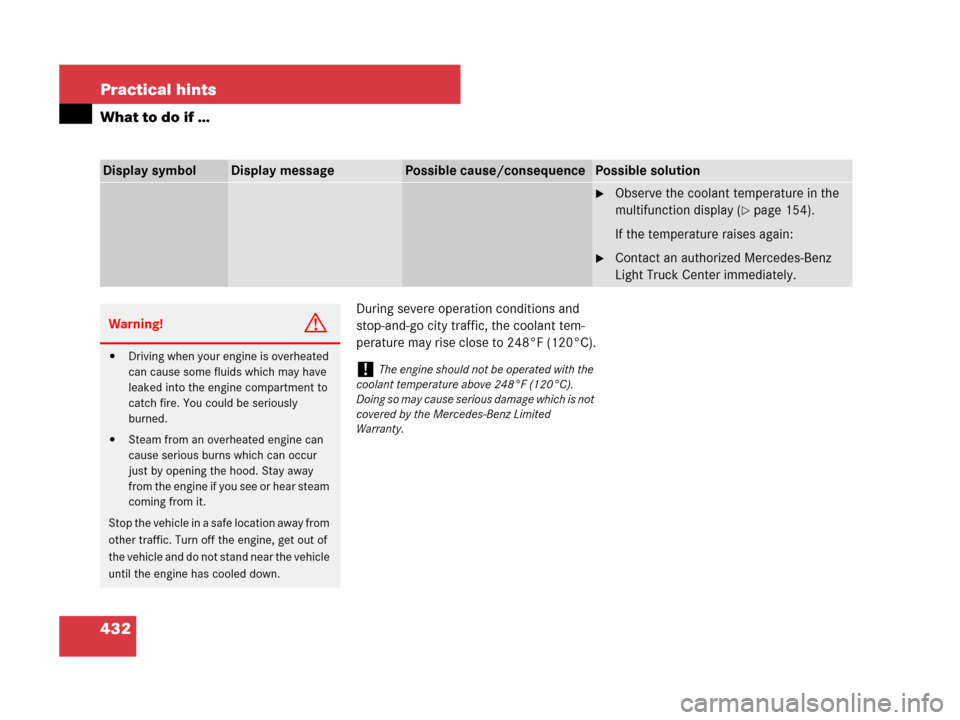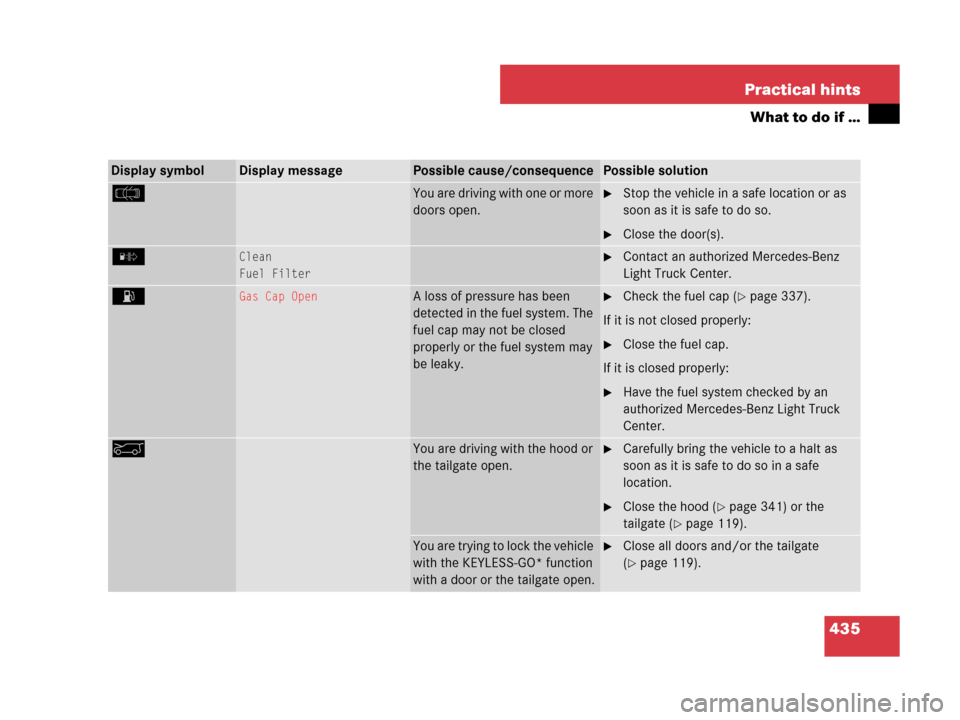Page 343 of 561
342 Operation
Engine compartment
The hood lock release lever is located in
the driver’s footwell.
1Release lever
�Pull release lever1 downwards.
The hood is unlocked. Handle2 pro-
trudes slightly from the radiator grille.
If not, lift the hood slightly.2Handle for opening the hood
�Press and hold handle2.
The hood is unlocked.
�Pull up on the hood in direction of ar-
row and then release it.
The hood will be automatically held
open at shoulder height by gas-filled
struts.
Warning!G
Vehicles with diesel engine:
The engine is equipped with a high-voltage
electronic control unit for the injection
system. Because of the high voltage it is
dangerous to touch any components of the
injection system (injectors, electrical wires)
�with the engine running
�while starting the engine
�when the ignition is switched on
!To avoid damage to the windshield wipers or
hood, never open the hood if the wiper arms are
folded forward away from the windshield.
Page 344 of 561

343 Operation
Engine compartment
Closing
�Let the hood drop from a height of
approximately 1 ft (30 cm).
The hood will lock audibly.
�Check to make sure the hood is fully
closed.
If you can raise the hood at a point
above the headlamps, then it is not
properly closed. Open it again and let it
drop with somewhat greater force.
Engine oil
The amount of oil your engine needs will
depend on a number of factors, including
driving style. Increased oil consumption
can occur when
�the vehicle is new
�the vehicle is driven frequently at
higher engine speeds
Engine oil consumption checks should only
be made after the vehicle break-in period.Checking engine oil level
When checking the oil level
�the vehicle must be parked on level
ground
�the vehicle must have been stationary
for at least 5 minutes with the engine
turned off
Example illustration ML 350 (ML 320 CDI,
ML 550, ML 63 AMG similar)
1Oil dipstick
2Upper mark
3Lower mark
Warning!G
When closing the hood, use extreme caution
not to catch hands or fingers. Be careful that
you do not close the hood on anyone.
Make sure that the hood is securely en-
gaged before driving off. Do not continue
driving if the hood can no longer engage af-
ter an accident, for example. The hood could
otherwise come loose while the vehicle is in
motion and injure you and/or others.
!Do not use any special lubricant additives,
as these may damage the drive assemblies.
Using special additives not approved by
Mercedes-Benz may cause damage not covered
by the Mercedes-Benz Limited Warranty.
More information on this subject is available at
any Mercedes-Benz Light Truck Center.
��
Page 345 of 561

344 Operation
Engine compartment
�Open the hood (�page 341).
�Pull out oil dipstick1.
�Wipe oil dipstick1 clean.
�Fully insert oil dipstick1 into the
dipstick guide tube.
�Pull out oil dipstick1 again after
approximately 3 seconds to obtain
accurate reading.
The oil level is correct when it is be-
tween lower mark3 (min.) and upper
mark2 (max.) of the oil dipstick.
�If necessary, add engine oil
(
�page 344).For more information on engine oil, see
“Technical data” section (
�page 522) and
(
�page 525).
Adding engine oil
Example illustration ML 320 CDI (ML 350,
ML 550 similar)
1Filler cap
ML 63 AMG
1Filler cap
iAll models (except ML 63 AMG):
The filling quantity between the upper and lower
marks on the oil dipstick is approximately
2.1 US qt. (2.0 l).
ML 63 AMG:
The filling quantity between the upper and lower
marks on the oil dipstick is approximately
1.6 US qt. (1.5 l).
!Only use approved engine oils and oil filters
required for vehicles with Maintenance System.
For a listing of approved engine oils and oil
filters, refer to the Factory Approved Service
Products pamphlet (USA only) in your vehicle
literature portfolio, or contact an authorized
Mercedes-Benz Light Truck Center.
Using engine oils and oil filters of specification
other than those expressly required for the
Maintenance System, or changing of oil and oil
filter at change intervals longer than those called
for by the Maintenance System will result in
engine or emission control system damage not
covered by the Mercedes-Benz Limited
Warranty.
��
Page 346 of 561

345 Operation
Engine compartment
�Unscrew filler cap1 from filler neck.
�Add engine oil as required. Never over-
fill with oil.
Be careful not to spill any oil when adding.
Avoid environmental damage caused by oil
entering the ground or water.
�Screw filler cap1 back on filler neck.
For more information on engine oil, see
“Technical data” section (
�page 522) and
(
�page 525).
Transmission fluid level
The transmission fluid level does not need
to be checked. If you notice transmission
fluid loss or gear shifting malfunctions,
have an authorized Mercedes-Benz Light
Truck Center check the automatic trans-
mission.
Coolant level
The engine coolant is a mixture of water
and anticorrosion/antifreeze.
When checking the coolant level
�the vehicle must be parked on level
ground
�the coolant temperature must be below
158°F (70°C)
!Excess oil must be siphoned or drained off.
It could cause damage to the engine and/or
catalytic converter (gasoline engine) or the oxi-
dation catalyst (diesel engine) not covered by
the Mercedes-Benz Limited Warranty.
Warning!G
In order to avoid potentially serious burns:
�Use extreme caution when opening the
hood if there are any signs of steam or
coolant leaking from the cooling system,
or if the coolant temperature display
indicates that the coolant is overheated.
�Do not remove pressure cap on coolant
reservoir if coolant temperature is
above 158°F (70°C). Allow engine to
cool down before removing cap. The
coolant reservoir contains hot fluid and
is under pressure.
�Using a rag, slowly open the cap approx-
imately 1/2 turn to relieve excess pres-
sure. If opened immediately, scalding
hot fluid and steam will be blown out
under pressure.
�Do not spill antifreeze on hot engine
parts. Antifreeze contains ethylene
glycol which may burn if it comes into
contact with hot engine parts.
Page 433 of 561

432 Practical hints
What to do if …
During severe operation conditions and
stop-and-go city traffic, the coolant tem-
perature may rise close to 248°F (120°C).
Display symbolDisplay messagePossible cause/consequencePossible solution
�Observe the coolant temperature in the
multifunction display (
�page 154).
If the temperature raises again:
�Contact an authorized Mercedes-Benz
Light Truck Center immediately.
Warning!G
�Driving when your engine is overheated
can cause some fluids which may have
leaked into the engine compartment to
catch fire. You could be seriously
burned.
�Steam from an overheated engine can
cause serious burns which can occur
just by opening the hood. Stay away
from the engine if you see or hear steam
coming from it.
Stop the vehicle in a safe location away from
other traffic. Turn off the engine, get out of
the vehicle and do not stand near the vehicle
until the engine has cooled down.
!The engine should not be operated with the
coolant temperature above 248°F (120°C).
Doing so may cause serious damage which is not
covered by the Mercedes-Benz Limited
Warranty.
Page 436 of 561

435 Practical hints
What to do if …
Display symbolDisplay messagePossible cause/consequencePossible solution
c You are driving with one or more
doors open.�Stop the vehicle in a safe location or as
soon as it is safe to do so.
�Close the door(s).
] Clean
Fuel Filter�Contact an authorized Mercedes-Benz
Light Truck Center.
AGas Cap OpenA loss of pressure has been
detected in the fuel system. The
fuel cap may not be closed
properly or the fuel system may
be leaky.�Check the fuel cap (�page 337).
If it is not closed properly:
�Close the fuel cap.
If it is closed properly:
�Have the fuel system checked by an
authorized Mercedes-Benz Light Truck
Center.
aYou are driving with the hood or
the tailgate open.�Carefully bring the vehicle to a halt as
soon as it is safe to do so in a safe
location.
�Close the hood (�page 341) or the
tailgate (
�page 119).
You are trying to lock the vehicle
with the KEYLESS-GO* function
with a door or the tailgate open.�Close all doors and/or the tailgate
(
�page 119).
Page 467 of 561
466 Practical hints
Replacing bulbs
Replacing bulbs for front lamps
Before you start to replace a bulb for a
front lamp, do the following first:
�Turn the exterior lamp switch to
positionM (
�page 135).
�Open the hood (�page 341).
1Housing cover for low beam halogen
headlamp
2Housing cover for high beam halogen
bulb (high beam and high beam flasher)
3Bulb socket for parking and standing
lamp bulb
4Bulb socket for turn signal lamp bulb
5Bulb socket for side marker lamp bulbLow beam bulb (halogen headlamp)
1Low beam headlamp cover
2Bulb socket for low beam headlamp
Page 474 of 561
473 Practical hints
Replacing bulbs
License plate lamp
1License plate lamp cover
2Screws
�Loosen screws2.
�Remove license plate lamp cover1.
�Replace the tubular bulb.
�Reinstall license plate lamp cover1.
�Retighten screws2.
Adjusting headlamp aim
VVertical centerline
HHeadlamp mounting height, measured
from the centerCorrect headlamp adjustment is extremely
important. To check and readjust a head-
lamp, follow the steps described:
�Park the vehicle on a level surface
25 feet (7.6 m) from a vertical test
screen or wall.
�Switch the headlamps on
(
�page 135).
If the beam does not show a beam pattern
as indicated in the figure left, then follow
the steps below:
�Open hood (�page 341).
iHigh beam adjustments simultaneously aim
the low beam.
Vehicle should have a normal tailgate load.
��